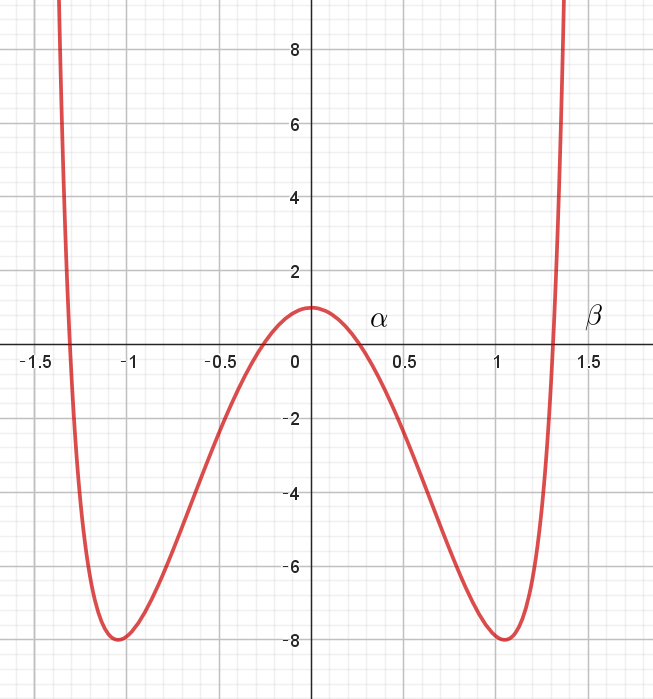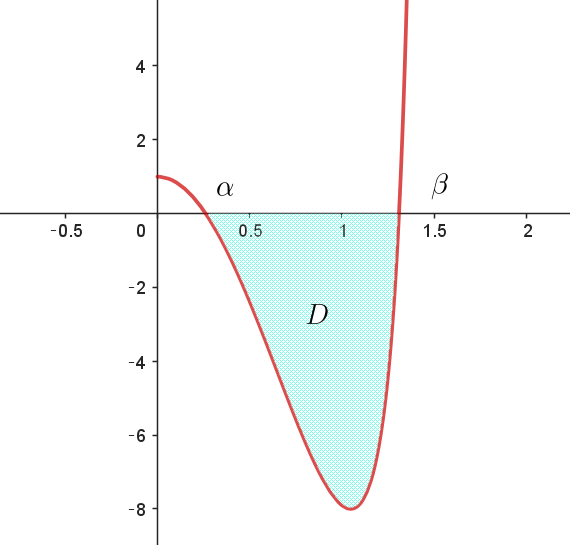電気通信大学 2024年 問題1
$区間 \ -\dfrac{\pi}{2} < x < \dfrac{\pi}{2}\ で定義された関数 \ f(x)=\dfrac{1}{\cos ^2x} - 16\sin ^2x \ \ について、以下の問いに答えよ。$
$(1)\ \ 0 < x < \dfrac{\pi}{2} \ の範囲における \ f(x)=0 \ の解を \ \alpha,\ \beta\ \ (\alpha < \beta ) \ とする。\alpha,\ \beta \ を求めよ。$
$(2)\ \ \tan \alpha,\ \ \tan \beta \ \ の値を求めよ。$
$(3)\ \ 関数 \ f(x)\ の導関数を \ f'(x) \ とする。-\dfrac{\pi}{2} < x < \dfrac{\pi}{2}\ の範囲における \ f'(x)=0\ の解をすべて求めよ。$
$(4)\ \ 区間 \ -\dfrac{\pi}{2} < x < \dfrac{\pi}{2}\ において、関数 \ f(x)\ の極値をすべて求めよ。$
$(5)\ \ 区間 \ 0 < x < \dfrac{\pi}{2}\ において、曲線 \ y=f(x)\ と \ x\ 軸で囲まれた領域を \ D\ とする。D\ の面積 \ S\ を求めよ。$
(1)
$f(x)=\dfrac{1}{\cos ^2x} - 16\sin ^2x =0 \quad より $
$\big(\dfrac{1}{\cos x} + 4\sin x\big) \big(\dfrac{1}{\cos x} - 4\sin x\big)=0$
$0 < x < \dfrac{\pi}{2} \ の範囲においては \ \ \sin x > 0, \ \ \cos x >0 \quad だから$
$\dfrac{1}{\cos x} - 4\sin x =0$
$4\sin x \cos x=1$
$\sin 2x=\cfrac{1}{2}$
$0 < 2x < \pi \quad より \quad 2x=\cfrac{\pi}{6},\quad \cfrac{5}{6}\pi$
$x=\cfrac{\pi}{12},\quad \cfrac{5}{12}\pi$
$したがって \quad \alpha =\cfrac{\pi}{12}, \quad \beta=\cfrac{5}{12}\pi$
(2)
$\tan \alpha=\tan \cfrac{\pi}{12}=\tan (\dfrac{\pi}{3}-\dfrac{\pi}{4}) \quad だから$
$\tan \alpha=\cfrac{\tan \dfrac{\pi}{3}- \tan \dfrac{\pi}{4}}{1+\tan \dfrac{\pi}{3}\tan \dfrac{\pi}{4}}=\cfrac{\sqrt{3}-1}{1+\sqrt{3} \times 1}=\cfrac{(\sqrt{3}-1)^2}{2}=2-\sqrt{3}$
$\tan \beta=\tan \cfrac{5}{12}\pi=\tan (\dfrac{\pi}{6}+\dfrac{\pi}{4}) \quad だから$
$\tan \beta=\cfrac{\tan \dfrac{\pi}{6}+ \tan \dfrac{\pi}{4}}{1-\tan \dfrac{\pi}{6}\tan \dfrac{\pi}{4}}=\cfrac{\dfrac{1}{\sqrt{3}}+1}{1-\dfrac{1}{\sqrt{3}} \times 1}=\cfrac{\sqrt{3}+1}{\sqrt{3}-1}=\cfrac{(\sqrt{3}+!)^2}{2}=2+\sqrt{3}$
(3)
$f(x)=\dfrac{1}{\cos ^2x} - 16\sin ^2x =0 \quad より $
\begin{eqnarray*} f'(x) &=&-\cfrac{2\cos x(-\sin x)}{\cos ^4 x}-32\sin x\cos x \\ \\ &=&\cfrac{2\sin x}{\cos ^3x}-32\sin x\cos x\\ \\ &=&\cfrac{2\sin x(1-16\cos ^4x)}{\cos ^3x}\\ \\ &=&\cfrac{2\sin x(1-2\cos x)(1+2\cos x)(1+4\cos ^2x)}{\cos ^3x}\\ \end{eqnarray*}
$-\dfrac{\pi}{2} < x < \dfrac{\pi}{2}\ \ の範囲における \ f'(x)=0\ の解は$
$\sin x=0 \ \ より \ \ x=0 \ \ と \ \ \cos x=\cfrac{1}{2} \ \ より \ \ x=\pm \cfrac{\pi}{3}$
(4)
$f(x)\ は偶関数だから対称性から \ \ 0 \leqq x < \cfrac{\pi}{2}\ \ で調べればよい。増減表は$
\[ \begin{array}{c||c|c|c|c|c} x & 0 & \cdots & \dfrac{\pi}{3} & \cdots & \dfrac{\pi}{2}\\ \hline f'(x) & 0 & - & 0 & + \\ \hline f(x) & 極大 & \searrow & 極小 & \nearrow \\ \end{array} \]

$x=0 \ で 極大値 \quad f(0)=1$
$x=\pm \cfrac{\pi}{3} で極小値 \quad f(\dfrac{\pi}{3})=\cfrac{1}{\cos ^2\dfrac{\pi}{3}}-16\sin ^2\dfrac{\pi}{3}=4-16 \times \cfrac{3}{4}=-8$
$なお、x \longrightarrow \pm \cfrac{\pi}{2} \ \ のとき \ \ f(x) \longrightarrow +\infty$
$y=f(x)\ のグラフは右図のとおりである。$
(5)

メインメニュー に戻る